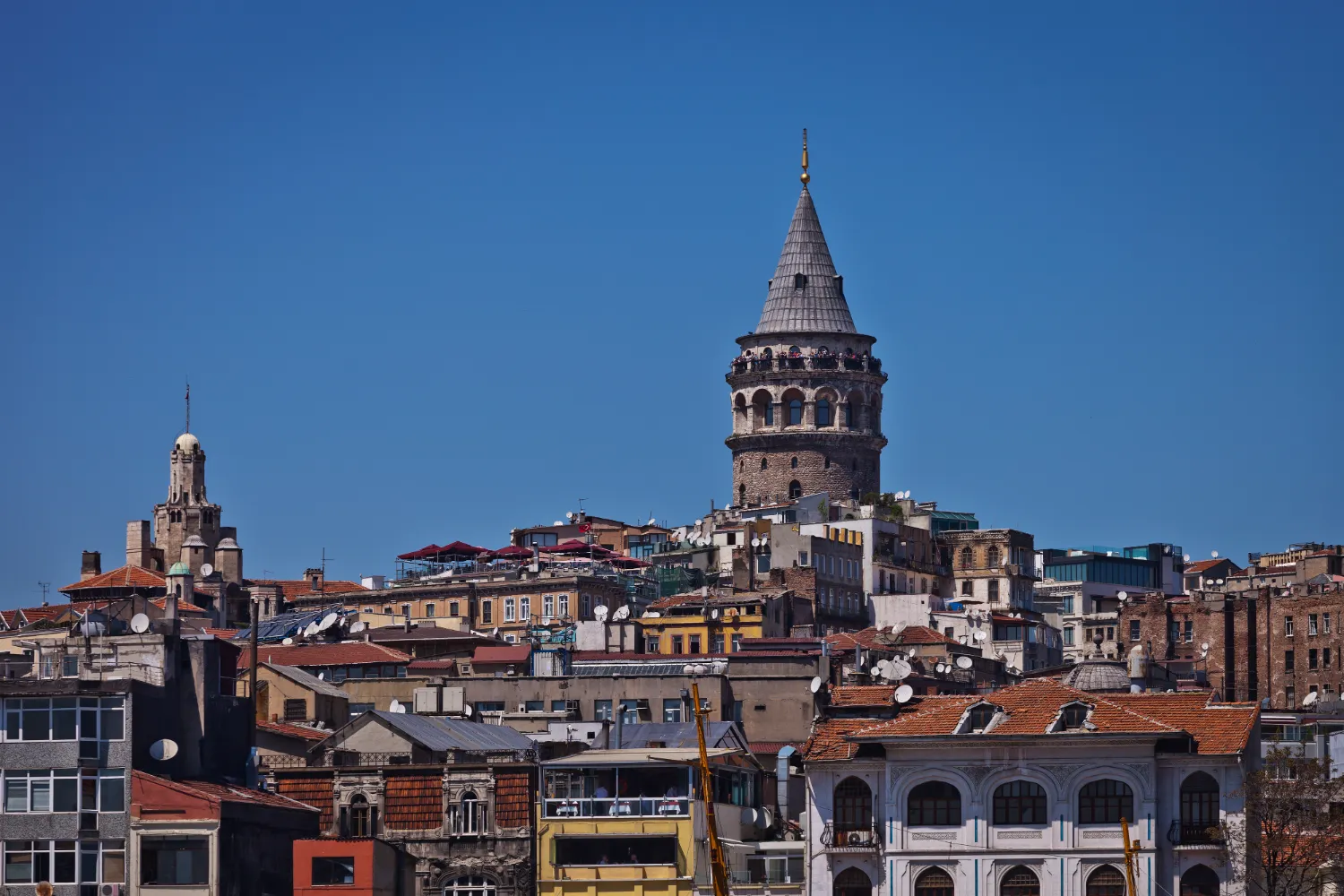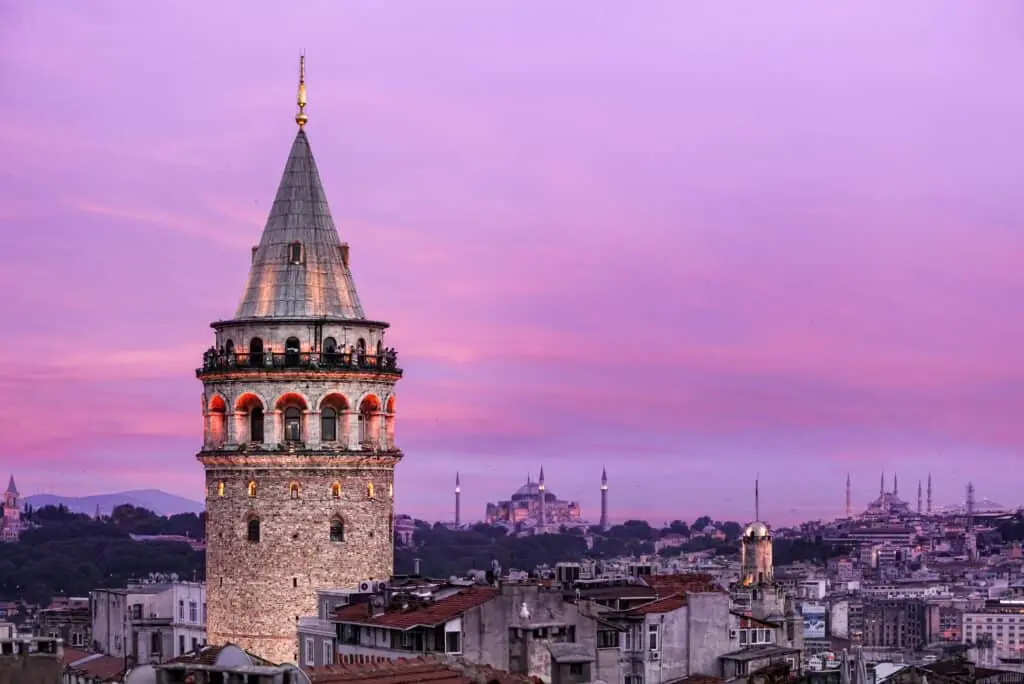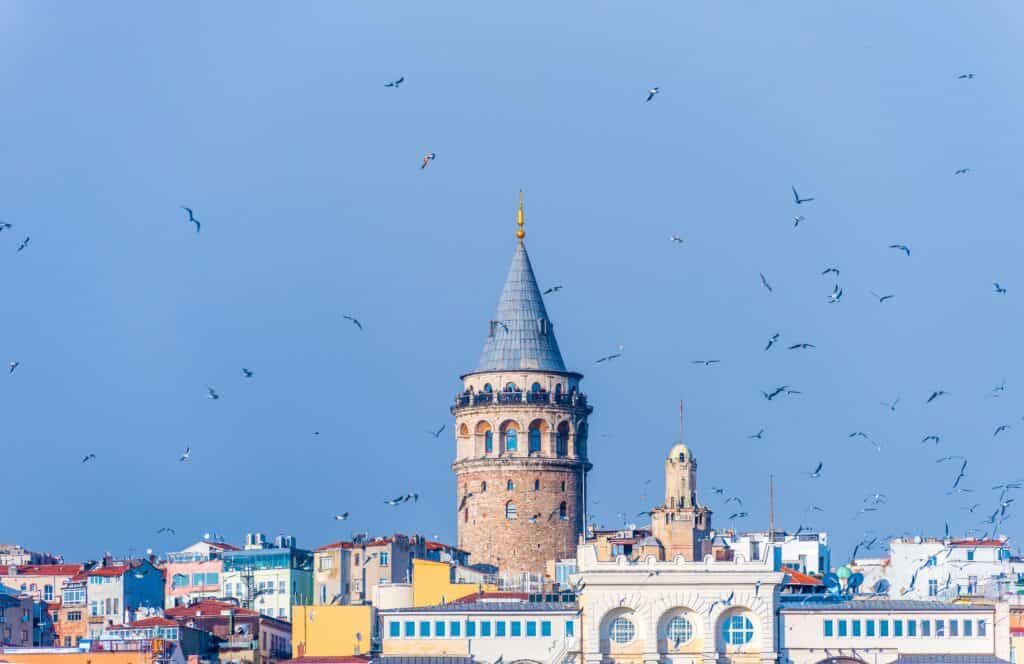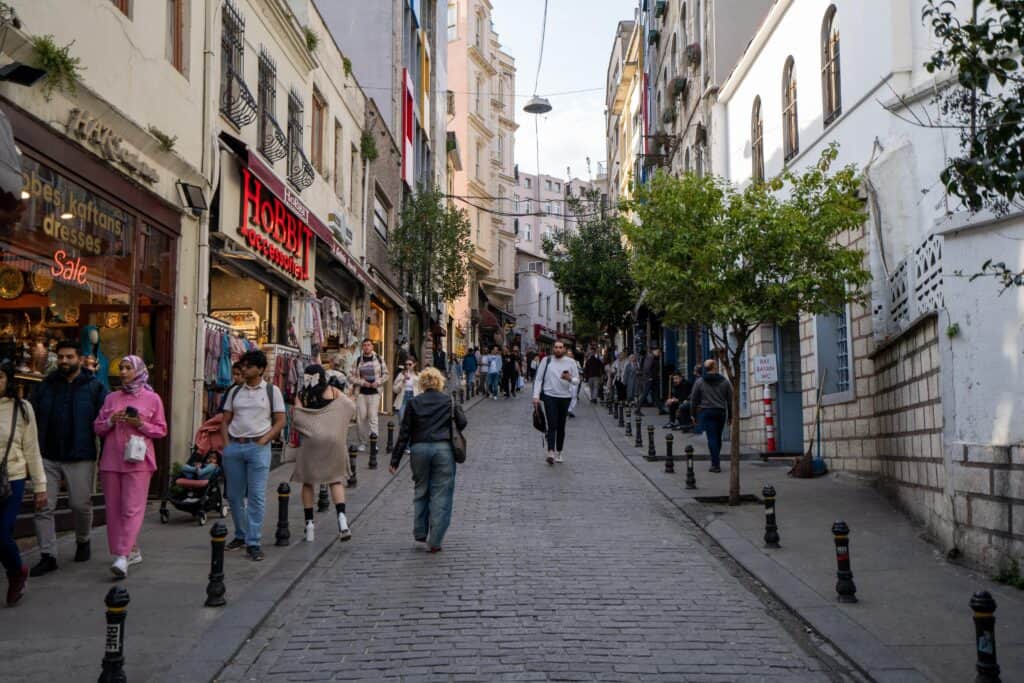Galata Tower: Its History, Construction and Amazing Nearby Landmarks

Updated On: November 08, 2023 by Fatma Mohamed
Galata Tower is a symbolic structure and one of the world’s oldest towers. It is one of the famous landmarks distinguishing the city of Istanbul.
It is also known as Galata Kulesi or Galata Kulesi Museum. The tower was included in the provisional list of UNESCO World Heritage in 2013 and was built as a watchtower within the Galata Walls. In 2020 it started to serve as an exhibition space and museum after it was used for different purposes in different periods.

It is considered the compass of tourists coming to Turkey to embrace the charm of Istanbul. The ancient tower construction goes back to the Middle Ages. Today it is still towering, attracting residents and foreigners to take unique memorial photos, especially since its 67 metres height offers a panoramic view of Istanbul in a scene that embraces the city’s charming beauty.
Location of The Tower
This tourist attraction is in Turkey. The tower’s name is derived from the Galata district, which is located in the Beyoğlu region of Istanbul. You can reach the Galata Tower on foot from Istiklal Street, Taksim Square, and Karakoy.
From Sultanahmet, the tram is also a suitable transportation by which you can reach a district close to it, Karakoy, in just 15 minutes. You may take the ” Tunel ” vehicle after getting off the tram. This one-stop metro will make you get to the beginning of Istiklal Street; it takes only 5 minutes from there to reach the place.
History of The Tower Construction
The Byzantine Emperor Justinianos first built the tower in 507-508 AD. The ancient Tower of Galata, “Megalos Pyrgos”, which means Great Tower, was built on the north side of the Golden Horn in Istanbul, located in the citadel of Galata. It was destroyed in the Fourth Crusade in 1204. This tower should not be confused with the present-time Galata Tower, which is still standing and placed at the citadel of Galata.
Genoese established a colony in the Galata part of Constantinople, with walls surrounding it. The current building was built at its highest point in the Romanesque style between 1348 and 1349. At that time, the 66.9 metres high tower was the tallest building in the city. It was called “Christea Turris” (Tower of Christ) because of the cross on its cone. After the conquest of Istanbul, the Galata Tower was left to the Ottomans by giving the key to Fatih Sultan Mehmet.
The marble inscription at the entrance shows that: “On Tuesday morning of 29 May 1453, the keys of the Galata colony was given to Fatih Sultan Mehmet, and the handover of Galata was completed on Friday, 1 June.”. In the 1500s, the building was damaged after an earthquake and was repaired by the Architect Murad bin Hayreddin III.
A bay window was added to the tower’s upper floor after the tower repairing during the Selim period. Unfortunately, the building faced another fire in 1831. As a result, Mahmut II added two floors above them, and the top of the tower was also covered with the famous cone-shaped roof. The building was last repaired in 1967. In 2020 the tower was restored and then reopened as a museum.
The Tower and Hezârfen Ahmed Çelebi Flying Story

Hezârfen Ahmed Çelebi, born in Istanbul in 1609 and died in Algeria in 1640, was one of the pioneers who tried to fly with industrial wings- like the bird wings; he planned and analysed the implementation of his attempt.
According to the Turkish legend, Ahmed “Hezarfen” tried to fly with wooden wings from the Galata Tower in 1632. He passed the Bosphorus and reached the Asian side neighbourhood of Üsküdar Dogancılar.
It is alleged that he was inspired by Leonardo Da Vinci and İsmail Cevherî, a Muslim-Turkish scientist who worked on the same matter long before he did. He also performed experiments before his historic flight as he wanted to measure the durability of his industrial wings, which he developed by studying the flight of birds. It is known that the interest in the tower gradually increased after that flight.
The Architecture of The Galata Tower
The height of the Romanesque-style cylindrical masonry tower is 62.59 m. Massive stones were used in the foundation of the building, which is located on rocky and clayey schist ground. The entrance door is higher than the ground and is reached by stairs made of marble steps on both sides.
The Structure and Design
The nine-storey tower is 62.59 metres high. It was built at a height of 61 metres above sea level. Its outer diameter reaches 16.45 metres at the base, and its inner diameter is around 8.95 metres, with 3.75-metre-thick walls. The wooden interior was replaced with a concrete structure during the restoration works.
There is a restaurant and café on the upper floors that overlook Istanbul and the Bosphorus. There are two elevators for the ascent of visitors from the basement to the upper floors. There is also a nightclub on the upper floors, which hosts entertainment shows.
A cone-shaped lead-lined reinforced concrete roof covers the top of the tower. There are four windows on the roof for views in all directions. On top of it is a gold-plated bronze part 7.41 m tall, according to Anadol’s statement and a 50 cm lantern with a flashing red light.
During the excavation in 1965 to strengthen the tower’s foundation, a tunnel passing through the centre of the sphere was founded at a depth of four metres. It is believed that the tunnel width is 70 cm, and its height is 140 cm. The tower extended down to the sea as a secret escape path during the Genoese period. After descending about 30 metres in the tunnel, distortions, rockfall, human skeletal rest, four skulls, ancient coins and an inscription were found.
Authorities concluded that the skeletons belonged to the prisoners who tried to drill a secret path from the tower, which was used as a prison during Kanuni (Suleiman the Magnificent – 1494/1566). They passed away after being interred under the ground.
Tourism Activities Near Galata Tower
A wide range of activities are available within a short distance from Galata Tower, such as visiting the shopping streets, dining at local restaurants, and exploring museums. Also, Istiklal Street, the most famous and marvellous pedestrian street in Istanbul, is very close to Galata Tower.
Mesrutiyet Street
Mesrutiyet Street is located next to Sishane Square, where historic hotels such as Pera Palace are located; the palace, from which the name of the famous Turkish series “Midnight at Pera Palace” was derived. This street stretches parallel to Istiklal Street, where some main tourist attractions are found, such as Pera Museum, Istanbul Modern and Mikla Restaurant.
Serdar-i Ekrem Street
The street extends from Galata Tower in Cihangir’s direction. There are many speciality shops that sell customised products. Additionally, there are boutique cafes with a very cosy atmosphere along the street that attract visitors.
You can also explore Nobel Prise-winning author Orhan Pamuk’s Museum of Innocence in the Cihangir neighbourhood on Serdar-i Ekrem Street.
Galip Dede Street

You can easily reach Istiklal Street from Galata Tower. When you start at the tower and follow Galip Dede Street in the northern direction, you will arrive at Tunnel Square, the beginning of Istiklal Street.
There is a lot to explore along Galip Dede Street; you can find souvenir shops, hostels, cafes, painting workshops and musical instrument shops. At the corner where Galip Dede Street meets Istiklal Street, there is the Galata Mevlevi House Museum.
Frequently Asked Questions About Galata Tower
You still have questions about the tower? Let’s get them answered!
Why is the Tower one of the most important landmarks in Istanbul?
The Galata Tower is one of the significant landmarks in Istanbul, not only for its exquisite engineering beauty but also for its historical value. The history of the Galata Tower goes back more than one thousand five hundred years. It witnessed wars, sieges, conquests, earthquakes, fires and plagues. Today, the tower became a destination for hordes of tourists flocking around the clock to see the magic of Istanbul. Also, the height of the building presents a fantastic panoramic view of Istanbul.
How much is the Galata Tower entrance fee?
The entrance fee for the Galata Tower in 2023 is around 350 Turkish Lira. Ticket prices for the tower were last updated on 1 April 2023. Also, the Istanbul Museum Entrance Permit is valid for entering the tower.
What are the working hours of Galata Tower?
The tower’s gates open daily at 08:30 am and close at 11:00 pm. There are usually long waiting lines, but you can get your tickets faster if you arrive early.
Check the tower’s site to ensure the working hours are not updated by the time you visit!
That’s All
Well! we came to the end of this historical journey. We would love to learn about your favourite landmark in Turkey.







Utterly indited subject matter, Really enjoyed looking at.